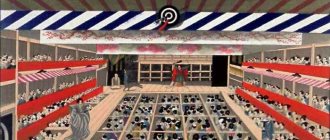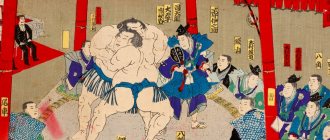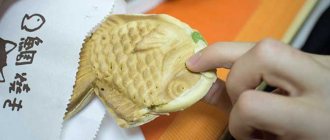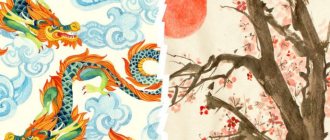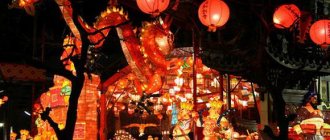Author: Varvara Lyutova
03 January 2021 11:20
Community: Facts
Tags: stories kimono fashion clothes where it came from changes in history styles evolution
8522
9
For centuries, style and fashion in Japan have been defined by one item: the kimono. It was not just a piece of clothing - it was a symbol of an entire culture, carrying symbolic meaning and embodying much more than what can be seen. Today we will try to trace the evolution of the kimono, starting from the 8th century AD, and evaluate its role in modern Japanese culture.
0
Source:
See all photos in the gallery
What does a Japanese kimono consist of?
But did you know that the word kimono literally means “clothing and article” in Japanese? That's why in Japan they don't just talk about the kimono, it has become a symbol of an entire culture. There are countless different types of kimono, each for different events in a person's life, social background, age and gender.
Traditional clothing in Japan. Since the mid-19th century, it has been considered the Japanese “national costume”. Kimonos are also the work clothes of geishas and maikos (future geishas).
A kimono is usually made up of different garments that come together to form a single piece. It is sewn from 4 pieces of fabric in the shape of the Russian letter “T”. The kimono itself is a loose robe that a person wears. Clothes are tied with a belt or belt. This belt is called obi in Japanese. Finally, there is a knot that holds the obi together called the yushibi. There are also various accessories that can be added to an outfit, a scarf, a pillow or a lanyard. However, this depends on the type of kimono.
The kimono has a scent right for men and women, except for funerals.
Formal and informal outfits
Depending on the degree of importance of the event, there are the following types of kimono - formal (haregi) and relatively formal (fudangi). Moreover, kharegs are further subdivided depending on the degree of importance:
- Kurotomesode - for married women in black with an image from the waist down for special occasions.
The kurotomesode belt is also decorated - Irotomesode is a kimono dress for informal occasions with a pattern from the waist down. Worn by all women, including married women.
Irotomesode has a wide variety of patterns - Furisode is a silk robe for unmarried girls with long, up to 1 m, sleeves. Dressed for formal events.
It is the sleeves that distinguish this type of kimono from others. - Iromuji is a plain kimono dress for tea ceremonies.
Tea ceremony - Komon is a dress with a small pattern for daily wear.
Komon looks quite simple when compared to formal types of kimono. - Homongi is an outfit for celebrations, decorated with images on the shoulders and sleeves.
Graceful Homongi - Tsukesage - similar to homongi, but for more trivial events.
Tsukesage of delicate color - Edokomon - samurai clothing. Now used by men for ceremonial events like homonga.
Traditional samurai outfit - Mofuku - decoration for mourning. The color and presence of distinctive signs depends on the closeness with the deceased.
Mofuku black - Haori - a kimono jacket worn over a dress gives formality.
A modern version of haori for men
- Avaze is a kimono coat with an insulated lining.
Japanese kimono with warm lining
The emergence of traditional costumes
How did the kimono as we know it today come about? Around the year 1000, Chinese fashion became increasingly popular in Japan. This was mainly caused by mass migration from mainland Asia to Japan during this period. The kimono became more and more beloved in Japan, both among the male and female population. At that time they only wore mo, which was more like a skirt.
However, this changed during the Muromachi period (1392-1573). During this period, more and more Japanese began to wear their kosode (small sleeves), an item of clothing that had previously been considered underwear. This kosode was previously worn only as underwear, then it was done with trousers or a skirt. The Kosode is very similar to the kimono as we know it! Over the years, a number of small changes have been made, such as the length of the sleeves, but overall the kimono has not changed since then.
Over the centuries, countless different styles of kimono have been developed, each with its own function, meaning and ideal use.
While the kimono used to be the “normal” clothing of the standard Japanese, today this is no longer the case. In the 20th centuries, Western influences on Japan increased. More and more Japanese began to wear trousers and a shirt, as we are used to seeing in Russia. Emperor Meiji in the late 20th century decreed that officials, including police and teachers, must wear Western clothing. This trend has continued since then.
This is why traditional kimonos in Japan are now only worn for special occasions such as parties or weddings. Kimonos are also often used for tourism purposes or in films.
Did you know that a kimono is the standard outfit for every Japanese geisha?
Additional costume elements
In addition to the robe, the costume includes many other details. The most popular of them are worth considering in more detail:
- sasoeke and hadajuban. Wide trousers and a thin shirt, which are used in the form of a kind of underwear;
- Juban. A long shirt with a cut reminiscent of a Japanese kimono. It is customary to wear it under the main item of clothing to avoid sweat getting on the outfit;
- hakama. Wide pleated pants or skirt;
- haori. A special model of jacket that is worn over a robe. Due to this, the image becomes more formal. The structure is secured with a cord called haori-himo;
- kanzashi. A special type of handmade jewelry. Often the motifs of pins echo the prints on the main item of clothing;
- tabi. Special socks with the big toe separated. This ensures maximum comfort when wearing shoes;
- zori. Sandals made of fabric or leather. Visually similar to slates;
- geta. Shoes made of wood. As a rule, such sandals are worn in an ensemble with a yukata;
- Varazdi. Sandals made from straw. Priests wear such shoes in temples;
- obi. A wide belt that complements the main outfit;
- okobo. High-soled shoes. It is possible to walk in it only in small steps. Otherwise, the girl may fall.
Japanese kimono is more than just clothing. This is part of Japanese culture, personifying the traditions of this people. Such costumes come in a wide variety and are selected taking into account the occasion for which they are used. Despite the fact that they appeared many centuries ago, such wardrobe items remain in demand to this day.
Kimono for women
Contrary to what many people think, kimonos are not just for women. No, men have been wearing kimonos for over 1000 years. However, it is true that kimonos are most often worn by women, both in the past and today.
As already mentioned, there are many different types of traditional costumes. One kimono is designed for formal occasions, the other for more casual occasions. The degree of formality of this traditional Japanese clothing is usually determined by the color and pattern.
It's not just about what kimono to wear. A woman's age and whether she is married also play a role.
The most common or "standard" kimonos for women are Furisode, Mofuku, Jūnihitoe and Komon.
Mofuku
Many modern Japanese women have lost the skill of putting on a kimono themselves: a traditional kimono contains twelve or more separate parts, so if necessary, they often turn to specialists in this field - otokoshi
Mofuku kimonos are worn in Japan only when someone has died. They are completely black and are worn only by those who were close to the deceased. Under the black kimono, people wear white silk underwear.
Price
Geisha dance kimono "hikizuri"
Kimono is an expensive luxury. A women's kimono can easily cost more than 300,000 rubles, and a complete set including the under kimono, obi, tabi, shoes and accessories can cost more than 600,000 rubles. One obi can cost more than thirty thousand. However, most kimonos kept by hobbyists or people practicing traditional arts are much cheaper. People in the entertainment industry wear standard kimonos, non-customized kimonos, or second-hand kimonos.
The material can also make a kimono cheaper. Hand-painted silk is often replaced with factory prints and simpler fabrics. There is also a developed business in Japan for the resale of used kimonos, which can cost about 500 yen or about 260 rubles. Thus, the obi becomes the most expensive item of clothing because it requires a skilled textile worker to produce it. Simple samples cost about 1,500 yen (about 770 rubles). Men's obi, even silk ones, are much cheaper due to their smaller size and less decorative effect.
Today, kimono clubs are common in Japan, where people learn to choose and wear them.
Juni-hitoe
Both women's and men's kimonos are worn with a wrap to the right.
At the funeral, the body is dressed in a kimono with a wrap to the left, they say, “The world after death is the opposite of our world.” Jūnihitoe is not just a kimono. No, these are the most complex, beautiful and therefore the most expensive kimonos! This is why they are only worn by women of the Japanese imperial family or people who work for them. The Jūnihitoe kimono is made up of several layers of fabric, each with its own unique colors and patterns. By the way, such kimonos are not cheap: they often cost tens of thousands of euros. They are also very heavy, weighing up to 20 kg. Currently, Jūnihitoe is only worn in the Japanese Imperial Palace. They can also be admired in various museums and exhibitions.
Character traits
Japanese kimonos are worn by both sexes and even children. The cut of this clothing is special. The model is created by applying geometric lines in the form of the letter T. It is not customary to fit it to a specific figure. We are talking not only about the width of the product, but also about its length. Accordingly, you can only order something with a strictly defined cut.
Info! Essentially, a kimano is a Japanese robe made of silk fabric. This is a long wrap dress with fairly wide sleeves, equipped with a wide belt and a bow in the back. The men's product is significantly narrower than the women's product, and is tied as close to the hips as possible.
The Japanese kimono creates an accent only in the area of the waist and shoulders. The figure in it is hidden, and existing imperfections are hidden. When putting on such clothing, it is adjusted to the wearer by creating characteristic folds. This design is fixed with the help of an obi belt .
When cutting clothes, a single piece of fabric is used. Its width is 40 cm , and its length varies between 9 – 12 m . Four stripes are created from this matter. Two of them are used to cover the body, and the other two are used to create sleeves. An overhead and main collar is additionally created from small strips. Also, a couple of narrow parts are used to decorate the front edges. All these elements have a rectangular shape. There are no curves on them.
The Japanese robe wraps to the right side. Due to this, the left part is always located on top, and the right one is inside, as close as possible to the body. The sleeves are visually similar to the bag. In men's models they are sewn in. In female versions, a hole called furitsyakuchi .
Sleeve length may vary. For example, in girls who have not yet married, as well as in future geishas, they reach a meter. Children's models look a little simpler. Due to this, there are no difficulties with putting on the product. This outfit resembles a quilted version of a robe and is made in brighter colors than adult models.
Traditional materials for creating clothes are satin and silk. Painting on fabric is usually done by hand. The patterns, their location, as well as the color of the item of clothing directly depend on the gender and age of the person, as well as his social status and the occasion for which the outfit is worn. The connection between the print and the season is also noted. For example, in spring, clothes are decorated with sakura flowers, and in winter, bamboo and pine trees are depicted on them.
Children's
Women's
Male
Komon
Unlike traditional European clothing, which emphasizes the structure of the human body, a kimono highlights only the shoulders and waist of the wearer, hiding the flaws of his figure.
Komon style kimonos are the most common as they are designed for everyday use. The Japanese word Komon means "pattern". Thus, kimono-komons have a beautiful permanent pattern.
Of course, there are many other styles for women besides these four styles, but these are the most important and common.
What about men?
Yes, kimonos are for men too! Okay, in the West you won't see men wearing them outside of the sauna or gym, but in Japan, kimonos are popular among men. The kimono has been a staple garment for over 1000 years. There are many differences between men's and women's kimonos. The most important of these is that kimonos for men are much simpler. The colors are often dark, muted and have a subtle pattern. The darker the color, the more formal the kimono. Of course, there are differences in terms of quality, material and price.
Views: 6,186
Share link:
- Tweet
- Share posts on Tumblr
- Telegram
- More
- by email
- Seal
Liked this:
Like
